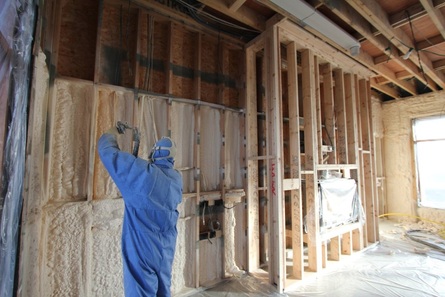 Air Tightness or Air Permeability ( air leakage ) is important in terms of achieving overall energy performance in your new home
Air Tightness or Air Permeability ( air leakage ) is important in terms of achieving overall energy performance in your new home The 'rubber hits the road' as far as conservation of fuel and energy in Irish homes is concerned with a document known as a technical guidance document. In this case it derives its powers from S.I. No. 259 of 2011 or for short "Part L" TGD, as it's known in the trade. Part L in turn superseded the previous Part L (SI No 497 of 1997). It's a bit confusing I agree. To cut to the chase, this latest Part L, TGD (technical guidance document) sets out various targets that should be aspired to particularly in relation to new dwellings. The standards are quite detailed and Part L looks at a number of parameters or performance attributes that should be met in order for the designer, developer and in turn the building owner to be compliant with current legislation.
These are:
a)Primary Energy Consumption and related Carbon Dioxide emissions
b)That a reasonable proportion of the total energy consumption of the dwelling is met by renewable energy sources
c)Limiting heat loss and increasing heat gain, through the building envelope
d)Installing energy efficient space and water heating combined with effective controls for same
e)If oil and gas boiler are installed in the dwelling, that they shall be at least 90% efficient
f)Provide the dwelling owner with enough information about the building mechanical and electrical so that he or she can operate the building in the most energy efficient manner possible.
So all of this looks fairly straightforward, just use a very good insulation, hit the U value targets, make my building as airtight as possible and bung in a 90% efficient boiler and I'm sorted? Easy?
Alas no!
As they say in Hollywood "It's complicated". The devil is in the detail and what's increasingly becoming clear is that in order to hit mathematical performance targets, the inclusion of a renewable technology in your home is effectively mandatory and no one is suggesting that any of this technology is cheap . Here's how the math work in practice (please brace yourself now for an acronym fest).
There are two figures that come centre stage in these calculations. The first is the EPC or "Energy Performance Coefficient" and this is calculated when the the calculated primary energy consumption of the proposed dwelling is divided by a factor known as "the reference dwelling" (see appendix C of Part L TGD) . The second figure needed is the CPC or to give it its full title "the carbon performance coefficient". Again this figure is calculated against a known reference called the "reference dwelling". Once these two figures are calculated it allows a third figure then be generated from the relationship between the previous two. This final figure is known as the "MPEPC" aka the "Maximum Permitted Energy Performance Coefficient". Currently this figure or ideal is 0.46.
In future blogs I'll be taking a look at the various renewable technologies on the market
Anthony
These are:
a)Primary Energy Consumption and related Carbon Dioxide emissions
b)That a reasonable proportion of the total energy consumption of the dwelling is met by renewable energy sources
c)Limiting heat loss and increasing heat gain, through the building envelope
d)Installing energy efficient space and water heating combined with effective controls for same
e)If oil and gas boiler are installed in the dwelling, that they shall be at least 90% efficient
f)Provide the dwelling owner with enough information about the building mechanical and electrical so that he or she can operate the building in the most energy efficient manner possible.
So all of this looks fairly straightforward, just use a very good insulation, hit the U value targets, make my building as airtight as possible and bung in a 90% efficient boiler and I'm sorted? Easy?
Alas no!
As they say in Hollywood "It's complicated". The devil is in the detail and what's increasingly becoming clear is that in order to hit mathematical performance targets, the inclusion of a renewable technology in your home is effectively mandatory and no one is suggesting that any of this technology is cheap . Here's how the math work in practice (please brace yourself now for an acronym fest).
There are two figures that come centre stage in these calculations. The first is the EPC or "Energy Performance Coefficient" and this is calculated when the the calculated primary energy consumption of the proposed dwelling is divided by a factor known as "the reference dwelling" (see appendix C of Part L TGD) . The second figure needed is the CPC or to give it its full title "the carbon performance coefficient". Again this figure is calculated against a known reference called the "reference dwelling". Once these two figures are calculated it allows a third figure then be generated from the relationship between the previous two. This final figure is known as the "MPEPC" aka the "Maximum Permitted Energy Performance Coefficient". Currently this figure or ideal is 0.46.
In future blogs I'll be taking a look at the various renewable technologies on the market
Anthony
 RSS Feed
RSS Feed